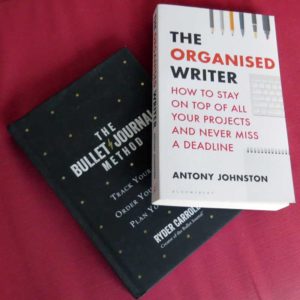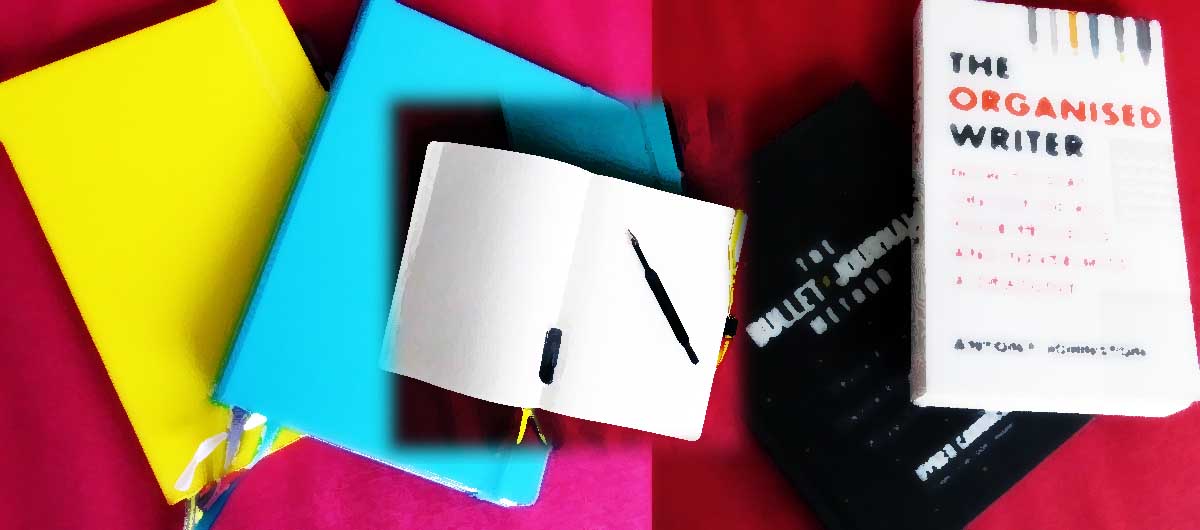Last week I wrote about feeling I had “cracked the code”. At last I knew how to go about keeping my New Year Resolutions. Part of this has been the help I’ve had to become more successfully organised from two books. The first of these is Ryder Caroll’s The Bullet Journal Method; the second, Antony Johnston’s The Organised Writer.
Better organised at Christmas
Am I an organised writer? I’m not sure. I’ve certainly become better organised as a person. And I think I’m a better organised writer now. There’s a distance still to go. But actually it’s encouraging and exciting to feel that I’ve only started to get the benefit of both these books. That I can see myself becoming even more successfully organised in the months ahead.
I’ve noticed that I’ve become better organised before, but it was brought very much to my attention over the last few weeks when I realised, coming up to Christmas, how calm I was. Nothing like my usual state of panic. I had foreseen many of my pre-season tasks and I had allowed time in my schedule for them. They didn’t suddenly rear up like a flood wave to break over my head. And when they bobbed up into consciousness, those tasks I’d forgotten about were easily accommodated.
It’s still possible there’s some major item I’ve forgotten that will emerge over the next twenty-four hours. If it does, I still think I’ll be in the right frame of mind to tackle it without too much stress.
(I feel I should add the following. That a) this year’s Christmas has been like no other I can remember, and being in semi-isolation has probably contributed to my calm. And that b) after publishing this post I had a very bad night and woke at about 3 a.m. from a dream in which I had indeed forgotten something profoundly important. Waking, I couldn’t think what it might be, though I couldn’t get back to sleep again. I sat up for a couple of hours, reading. Added Christmas Day 2020.)
Bulleted
It was The Bullet Journal Method that came first. I started keeping my first Bullet Journal in the middle of May. This was parallel with reading Ryder Caroll’s book describing the method.

As I mentioned last week, I’d already started keeping a notebook in order to keep track of the books I was reading. For many years, also, I’d kept a little diary where I listed appointments and deadlines. (And kept a record of my state of mind.) Then I had scraps of paper with to-do lists tucked away here and there (and a small graveyard of to-do list apps on my phone). And I was carrying a notebook around with me to jot down story ideas and conversations overheard. In other words I had several of the elements of a Bullet Journal, but distributed in different places for different purposes. And, yes it was difficult to keep track of them all.
I thought, There must be a better way of doing this. So I went looking. And that was how I found Bullet Journalling.
The first thing that appealed to me about Bullet Journalling was that it encouraged me to give up on separate notebooks and sanctioned putting everything, private and professional, in the same place. The second thing was the mindful element that is baked into the method. Being mindful of one’s commitments and the time one has available is key to using one’s time wisely. Being mindful of what each task involves helps me to decide how best to approach it. Breaking the tasks down into smaller elements makes it easier to accomplish big tasks with small steps.
Mindful day by day
For me, all this means I now take each day as it comes. The evening before I make a list in my Journal of the tasks and appointments I have for the coming day. At the beginning of the day, I look through the tasks I have set myself for the day. I plan how I will tackle each one and then I go forward with that plan. I don’t worry about having to change the plan, or skip over items or add new ones, I just move forward.

When ideas come to me. Or I come across good quotes in the books I’m reading. Or when I overhear a conversations. Those notes go into the Journal too, in amongst all the bulleted to-do tasks.
At the end of the day I assess my degree of success on my various tasks. In light of this, I plan the next day, adjusting the tasks I set myself accordingly. Other notes get earmarked for future processing or transferred to the computer into appropriate files. And really that’s all there is to it. A day by day progression with a complete record of what I’ve done and what I plan to do all in one place. And time earmarked every morning and evening to carry out my review of the day and plan for the day to come.
As I wrote last week, the best way to accomplish a New Year resolution seems to be to revisit it regularly. The Bullet Journal Method helps me because it requires me to revisit all the tasks I’ve set myself on a daily and monthly basis.
Successfully organised
Johnston’s The Organised Writer wasn’t published till the autumn of this year. Once I’d read it through and decided I wanted to use it, this meant adapting my Bullet Journal to Johnston’s approach. Had I met the books in the reverse order, I suspect it would have been more difficult to make them work for me. In part this is because Johnston puts a great deal of emphasis on using electronic software. He doesn’t dismiss journalling with a pen on paper, but you can tell it’s not his preferred method.
I have tried working with apps, (evidence: my to-do list graveyard), but I have been disappointed. Of course I am not nearly as busy as Antony Johnston. I do not find myself juggling a half-dozen different professional projects with different deadlines for different publishers. If I did, I might put more store by using electronic devices. I might be more interested in backing up to the cloud and working on the move. As it is, the physicality of my Bullet Journal is more satisfactory. The feel of a pen in my hand. The scratching of a nib on paper. The trail of ink. All these are more appealing to me.
At the same time a lot of the practical ideas and suggestions in Johnston’s book are easily transferable to bullet journalling. And to be fair he does recommend bullet journalling as one option for “content management”, even if he doesn’t set much store by himself.
But setting the technology aside, Johnston has a deep understanding of the procrastinating writer. He is, I strongly suspect, a fellow traveller in this particular vale of tears. Understanding the excuses one makes and the delaying tactics one adopts, his suggestions for overcoming these hurdles are very practical. Very doable.

A creature of routine
One mantra he has is the importance of working regularly. “The best way to be a more productive writer is to become a creature of routine and habits.” This is something I realise I’ve been reaching for myself for years. Also something I was beginning to get a grip on even before reading the Organised Writer. What is the morning and evening planning and review ritual of my Bullet Journal if not a routine habit?
As mentioned, although I feel both the Bullet Journal method and the Organised Writer have helped me in 2020, I’m still exploring them both and still applying them. Ryder Carroll’s Bullet Journal method is flexible and very easy to personalise; Johnston’s Organised Writer, in its own way, is similarly adaptable. I’m looking forward to a successfully organised future with both of them by my side.




